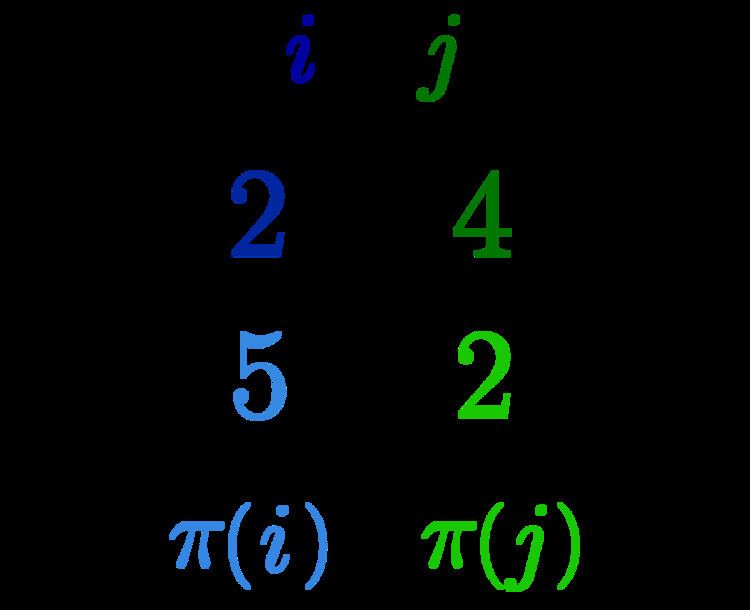 | ||
In computer science and discrete mathematics a sequence has an inversion where two of its elements are out of their natural order.
Contents
Inversion
Let
The inversion is usually defined for permutations, but may also be defined for sequences:
Let
For sequences inversions according to the element-based definition are not unique, because different pairs of places may have the same pair of values.
The inversion set is the set of all inversions. A permutation's inversion set according to the place-based definition is that of the inverse permutation's inversion set according to the element-based definition, and vice versa, just with the elements of the pairs exchanged.
Inversion number
The inversion number is the cardinality of inversion set. It is a common measure of the sortedness of a permutation or sequence.
It is the number of crossings in the arrow diagram of the permutation, its Kendall tau distance from the identity permutation, and the sum of each of the inversion related vectors defined below.
It does not matter if the place-based or the element-based definition of inversion is used to define the inversion number, because a permutation and its inverse have the same number of inversions.
Other measures of (pre-)sortedness include the minimum number of elements that can be deleted from the sequence to yield a fully sorted sequence, the number and lengths of sorted "runs" within the sequence, the Spearman footrule (sum of distances of each element from its sorted position), and the smallest number of exchanges needed to sort the sequence. Standard comparison sorting algorithms can be adapted to compute the inversion number in time O(n log n).
Inversion related vectors
Three similar vectors are in use that condense the inversions of a permutation into a vector that uniquely determines it. They are often called inversion vector or Lehmer code. (A list of sources is found here.)
This article uses the term inversion vector (
Inversion vector
With the element-based definition
Left inversion count
With the place-based definition
Right inversion count
With the place-based definition
Both
Example: All permutations of four elements
The following sortable table shows the 24 permutations of four elements with their place-based inversion sets, inversion related vectors and inversion numbers. (The small columns are reflections of the columns next to them, and can be used to sort them in colexicographic order.)
It can be seen that
The default order of the table is reverse colex order by
Weak order of permutations
The set of permutations on n items can be given the structure of a partial order, called the weak order of permutations, which forms a lattice.
The Hasse diagram of the inversion sets ordered by the subset relation forms the skeleton of a permutohedron.
If a permutation is assigned to each inversion set using the place-based definition, the resulting order of permutations is that of the permutohedron, where an edge corresponds to the swapping of two elements with consecutive values. This is the weak order of permutations. The identity is its minimum, and the permutation formed by reversing the identity is its maximum.
If a permutation were assigned to each inversion set using the element-based definition, the resulting order of permutations would be that of a Cayley graph, where an edge corresponds to the swapping of two elements on consecutive places. This Cayley graph of the symmetric group is similar to its permutohedron, but with each permutation replaced by its inverse.
